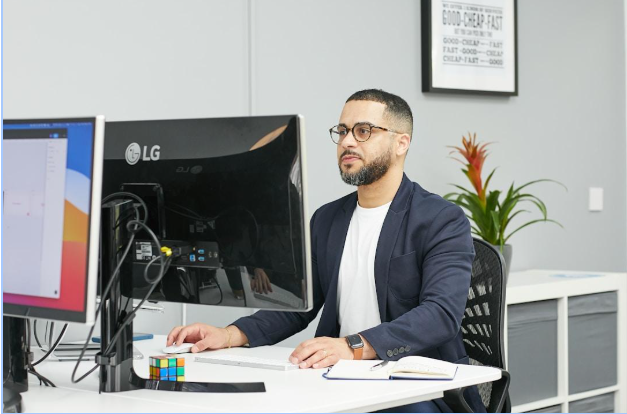
In the grand history of cinema, many names have been etched in gold for their artistic brilliance or technological contributions. However, few stand out for their advocacy and pioneering work for inclusivity like Emerson Romero, a Cuban-American actor, inventor, and accessibility advocate. His contributions went far beyond the screen, leaving a lasting impact on how media could become more inclusive for the deaf and hard-of-hearing communities. Despite being born into a time when deafness was seen as a major social barrier, Romero shattered assumptions by transforming how silent and talkie films were experienced by the deaf. This article presents a full exploration of Emerson Romero’s life, career, and legacy, while addressing key elements of accessibility in entertainment and how his early inventions shaped modern captioning practices.
Early Life and Deaf Identity in Context
Born in Havana, Cuba, in 1900, Emerson Romero moved to the United States during his childhood. At the age of six, Romero became deaf due to illness—a life-altering event that would later influence his contributions to the world of media. Despite his disability, Romero never allowed deafness to define his limitations. He attended the New York School for the Deaf, where he began his journey into acting and storytelling. At a time when mainstream society offered limited resources for deaf individuals, Romero’s determination to engage in the performing arts was nothing short of revolutionary.
Entrance Into Silent Films: The Hollywood Dream
The 1920s were known as the golden age of silent films. These productions, devoid of spoken dialogue, ironically provided a unique opportunity for deaf actors and audiences alike. Emerson Romero seized this moment and began acting in silent films, taking part in various short comedies and vaudeville-type productions. His expressive face and excellent comedic timing made him a favorite among certain circles. He understood the nuances of storytelling through gesture, expression, and body language—a perfect fit for silent cinema. However, the transition to sound films in the late 1920s brought about significant challenges for deaf professionals.
The Sound Barrier: Decline of Silent Films and Accessibility Crisis
With the emergence of talkies—films with synchronized sound—came the unintended exclusion of deaf audiences from cinematic experiences. What was once accessible through visuals suddenly became a closed door due to the heavy reliance on spoken dialogue. For deaf actors, including Romero, this shift meant fewer acting opportunities. For deaf audiences, it created a void in accessibility. Romero recognized this problem early on and turned his attention from acting to invention, seeking ways to restore access to films for the deaf community.
Inventing Film Captioning: Romero’s DIY Solution
In 1947, Emerson Romero pioneered one of the first practical methods of open captioning. Using discarded 16mm films, he physically sliced open the film reels and inserted typewritten intertitles between scenes, similar to how silent films delivered dialogue. His rudimentary yet impactful method involved cutting and gluing paper captions directly onto the filmstrip—an arduous task that drastically slowed down projection speed but allowed deaf viewers to follow along with the story. This innovation, though not commercially scalable, set the precedent for future captioning systems.
From Individual Innovation to National Advocacy
Romero’s film captioning work was not conducted in isolation. He partnered with national deaf advocacy organizations such as the National Association of the Deaf (NAD), and his prototype captioned films were distributed to schools and deaf clubs across America. His efforts influenced future developments in educational media accessibility and later inspired the NAD to campaign for captioned TV and cinema. Emerson Romero’s work wasn’t just technical—it was deeply political. He advocated for the deaf community’s right to access entertainment, culture, and information equally.
Comparison Table: Pre- and Post-Romero Film Accessibility
| Feature | Before Romero (Pre-1947) | After Romero (Post-1947) |
| Caption Availability | None | Prototype Intertitles |
| Deaf-Friendly Film Options | Limited | Growing Distribution |
| Advocacy Presence | Low | Active Campaigns Began |
| Technological Solutions | Nonexistent | Romero’s DIY Captioning |
| Media Inclusion Awareness | Marginalized | Gradual National Focus |
Impact on Modern Captioning Technologies
Although Romero’s method was not ideal for mass production, it demonstrated the feasibility and necessity of captioning. By the 1960s and 1970s, more advanced forms of captioning emerged, culminating in technologies like closed captioning for television. These systems owe their conceptual groundwork to innovators like Emerson Romero. Today’s digital subtitles, streaming caption options, and even real-time speech-to-text services reflect the same core philosophy: accessibility for all, especially the deaf and hard-of-hearing.
Emerson Romero’s Legacy in Deaf Culture
Emerson Romero is often celebrated within the deaf community as more than just a technical pioneer—he’s regarded as a cultural hero. His proactive mindset and refusal to accept marginalization inspired generations of deaf individuals to advocate for their rights. Romero not only elevated the discussion around film accessibility but also brought visibility to the talents of deaf performers in an industry that often overlooked them.
Recognition and Modern-Day Influence
Though Romero died in 1972, his contributions have since been recognized through various honors and academic references. Institutions focused on media accessibility often cite his work as foundational. Educational documentaries on deaf culture, like those produced by Gallaudet University, include his story as a prime example of grassroots innovation. Moreover, several accessibility developers have credited Romero’s cut-and-paste method as their starting inspiration.
How Today’s Filmmakers Can Learn from Romero
Modern filmmakers and content creators should look to Romero’s efforts as a call to action. With AI-driven captioning, multi-language subtitles, and screen-reader integration, there are no excuses for ignoring accessibility. Romero’s legacy teaches that even without institutional support, change is possible through initiative and creativity. By including captioning as a default design feature, today’s content can avoid the mistakes of the talkie era.
Captioning in the Age of Streaming Services
Streaming platforms like Netflix, YouTube, and Hulu now offer subtitles in dozens of languages, and accessibility has become a legal requirement in many countries. Romero’s influence is evident here. His advocacy helped spark movements that would eventually lead to legislation like the Americans with Disabilities Act (ADA), which enforces accessibility standards across digital and media platforms. It’s a powerful reminder that individual action can lead to systemic change.
The Global Spread of Accessible Media
Today, countries around the world have adopted captioning as a standard. From Japan’s NHK broadcasting subtitles for elderly audiences to India’s push for multi-lingual closed captioning in education, Romero’s foundational ideas have transcended borders. The globalization of accessible media owes a great deal to early champions like Emerson Romero.
Charting the Evolution of Captioning Technology
| Decade | Milestone | Contribution Type |
| 1920s | Silent Films Era | Implicit Accessibility |
| 1940s | Romero’s Captioning Method | Open Caption Innovation |
| 1960s | Captioned Educational Films | Institutional Support |
| 1980s | Closed Captioning for TV | Broadcast Legislation |
| 2010s+ | AI & Real-Time Captions | Tech Integration |
Continuing Romero’s Mission in the Digital Age
In an era of digital abundance, Romero’s mission continues through grassroots activists, accessibility tech companies, and media educators. YouTube content creators now include auto-generated captions. TikTok influencers incorporate visual storytelling for deaf users. The entertainment industry still has room for growth, but it’s undeniably on a path that Emerson Romero once cleared with scissors, glue, and a visionary mind.
Conclusion: Emerson Romero’s Message Still Echoes
Emerson Romero didn’t just invent a way to caption films—he started a movement. His life’s work reminds us that accessibility is not a luxury but a right. From analog filmstrips to today’s real-time subtitles, the world has come a long way thanks to pioneers like him. As we push forward in making media more inclusive, Romero’s legacy stands as both a guiding light and a challenge: how can we do better for those often left out of the conversation?
5 Key Takeaways
- Emerson Romero was one of the first to create open captions for films in the 1940s.
- He bridged the gap between silent film accessibility and the exclusion of deaf audiences during the sound film era.
- Romero’s handmade captions inspired national organizations and accessibility standards.
- Modern captioning in streaming platforms and television owes conceptual credit to Romero.
- His advocacy helped lay the foundation for later legal reforms like the ADA.
Frequently Asked Questions
1. What was Emerson Romero’s biggest contribution to accessibility?
He created one of the first open captioning methods for sound films in 1947, allowing deaf audiences to access media content.
2. Did Emerson Romero receive awards for his work?
While he wasn’t widely recognized during his lifetime, his work has since been acknowledged by deaf advocacy organizations and educational institutions.
3. How is Emerson Romero’s legacy relevant today?
His legacy lives on in today’s digital media accessibility efforts, including AI-based subtitles, closed captions, and accessible design in streaming platforms.





